LA museum enlists volunteers in search for bugs, plants
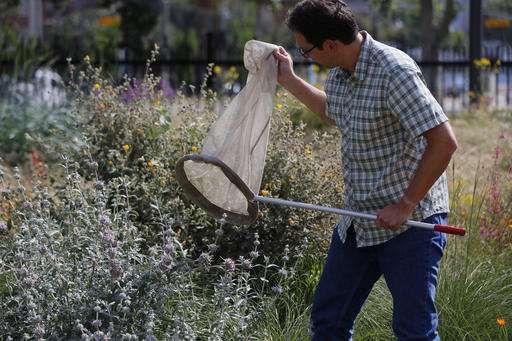
Long before Southern California was paved over with freeways and covered with cars and millions of people, it was teeming with snakes, slugs, spiders, snails and uncounted other slimy, creepy, crawly creatures.
And it still is, say scientists at the Los Angeles County Natural History Museum who are intent on building a better world by enlisting thousands of people to find and catalog those creatures.
On Thursday, the scientists will unveil the museum's Urban Nature Research Center, a facility that director Lori Bettison-Varga says will serve as headquarters for the nation's first urban biodiversity study that uses a sprawling city and its environs as a research lab.
"Everybody thinks that Los Angeles is just this big, paved-over place, but it's not. It's a hotbed of biodiversity," says Lila Higgins, head of the center's citizen-science program.
The scientists recently trained about 400 volunteers and armed some with backyard traps. Now, they will beat the bushes and other spots in their neighborhoods in search of unusual flora and fauna. Some bugs will be taken to the center and examined while many more will have their photos taken and emailed to the facility's 12 staffers for a closer look.
The volunteers are helping with such playfully named projects as RASCAL (reptiles and amphibians in Southern California) and SLIME (snails and slugs living in metropolitan environments).
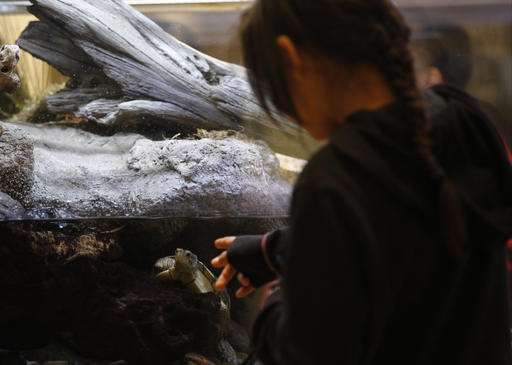
Meanwhile, the museum is encouraging anyone with a smartphone to snap a photo of interesting bugs, reptiles or plants and send it along.
The environmental group Conservation International has placed Southern California on its list of 35 biodiversity hotspots—places with a hugely diverse ecosystem that includes numerous plants, insects, lizards and the like along with large numbers of threatened flora and fauna.
In Southern California, for example, museum scientists have discovered 43 species of phorid flies in recent years that they never knew existed in the region.
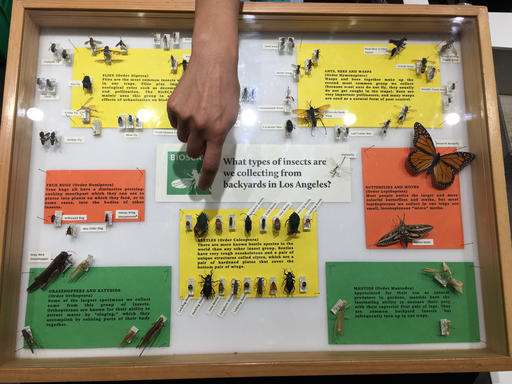
"There's nothing super-special about phorid flies, except to us of course, because we're experts on them," Brian Brown, the museum's entomology curator, said with a smile Wednesday as a bunch of the flies were being meticulously examined in a ground-floor exhibit hall while a group of schoolchildren looked on google-eyed.
"But they are indicators of what might also be here, and it just points out how little known this city is," Brown said. "Even though there are scientific institutions that have been here over a hundred years, we still don't know what species live here."
And of those that are known, it isn't clear how many of them got here.
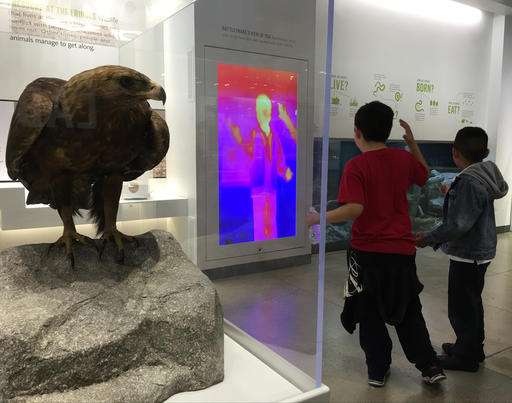
One of the most common species of fruit fly—those teeny tiny bugs with a taste for rotten bananas and an annoying dive-bombing maneuverability—in Southern California was recently discovered to have come from a species native to El Salvador. Its ancestors likely arrived here the same way as an Australian gecko discovered by the museum—hitching a ride on a plane or ship filled with plants or food.
Brown says keeping track of such transplanted insects and reptiles helps keep the ecology in balance.
"If there are 5,000 species and a nasty invasive species gets in, it's much harder for it to get established," he said.
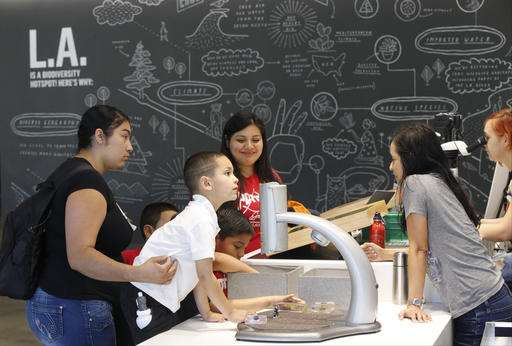
Having finished talking about flies, he ventured outside to the center's 3.5-acre garden, a stone's throw from University of Southern California residence halls across a street divided by a busy commuter rail line.
Armed with a butterfly net, Higgins quickly rounded up a ladybug while Brown flipped over a small bench and uncovered an army of obscure bugs, each of which he could name.
Such curiosity helped lead to the founding of the center after the museum asked people in 2002 to show them any interesting spiders they came across for a study being done by Brown and colleagues. They quickly got 5,000 specimens.
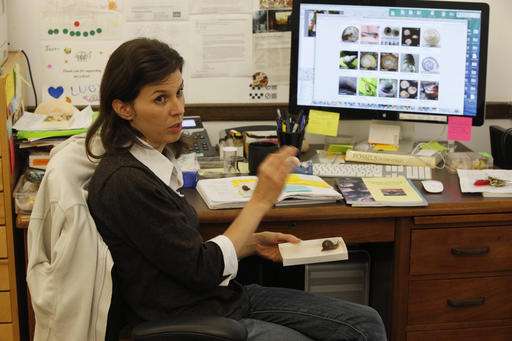
"We thought, 'What else can we do with the public?'" the entomologist recalled.
Although the information collected by the Urban Nature Research Center is largely for scientists, Bettison-Varga said it can also benefit urban planners as they propose future projects for this dense area.
With a bit of passion in his eyes, Brown said a better world for bugs and plants makes a better place for people, explaining that decomposition of bugs, plants and other life improves the soil, which grows the plants that clean the air. Paving over certain habitat disturbs all that.
"Ultimately the goal is to make L.A. a better place for biodiversity and for humans," he said.
-
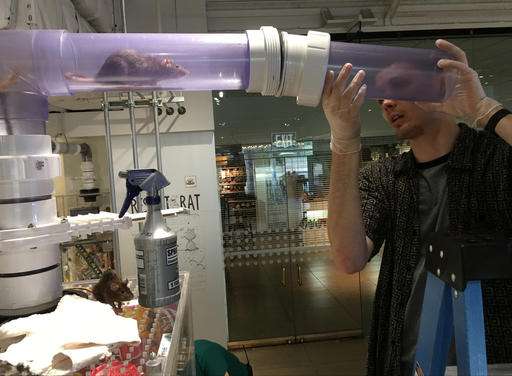
A museum staff member cleans a clear duct, part of the an exhibit of live rats displayed at the Urban Nature Research Center in the Los Angeles' Natural History Museum, on Wednesday, April 13, 2016. Long before Southern California was paved over with freeways and a concrete-bottomed river, covered in cars and trod upon by millions of people, it was teeming with snakes, slugs, spiders, snails and uncounted numbers of other slimy, creepy, crawly creatures. (AP Photo/Damian Dovarganes) -
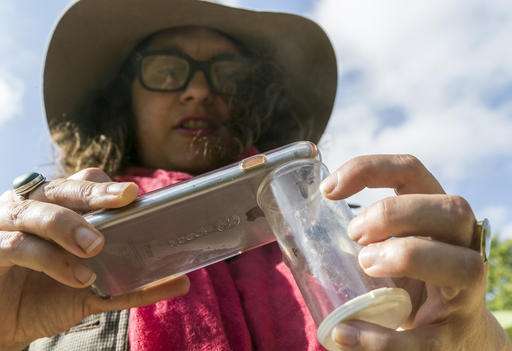
Lila Higgins, who heads the center's citizen-science program, photographs a European honey bee with her iPhone's camera at the Urban Nature Research Center gardens at Los Angeles' Natural History Museum, on Wednesday, April 13, 2016. BioSCAN, the world's largest urban biodiversity study is counting on the thousands of citizen-scientists across Southern California. They trained about 400 volunteers who came to the center last spring, some who left with backyard traps. They are encouraging everyone with a smartphone to snap a photo of any interesting bug, reptile or plant they find in their backyard and send it to them. (AP Photo/Damian Dovarganes) -
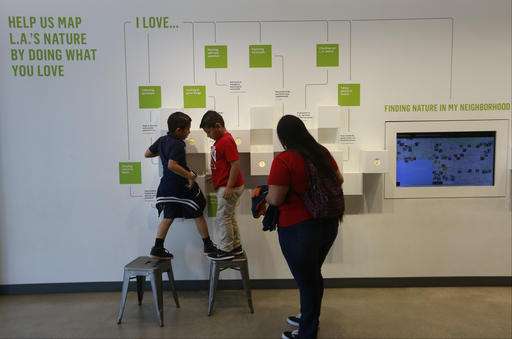
School children explore a sample of Los Angeles nature displayed at the Urban Nature Research Center in Los Angeles' Natural History Museum, on Wednesday, April 13, 2016. BioSCAN, the world's largest urban biodiversity study is counting on the thousands of citizen-scientists they are deputizing across Southern California. (AP Photo/Damian Dovarganes) -
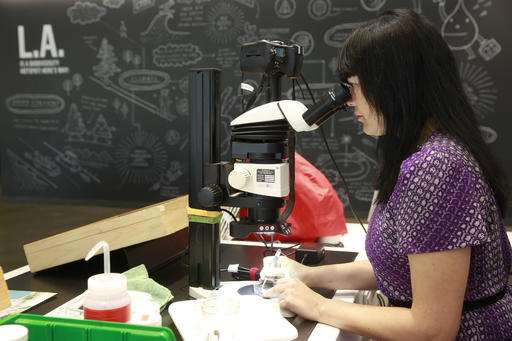
Lisa Gonzalez, Assistant Collections Manager of the BioScan project uses a microscope to scan a collection of urban insects at the Urban Nature Research Center at the Los Angeles' Natural History Museum, on Wednesday, April 13, 2016. Since the center opened in 2013, scientists have discovered 43 species of phorid flies they never knew existed here. (AP Photo/Damian Dovarganes)
© 2016 The Associated Press. All rights reserved.





















